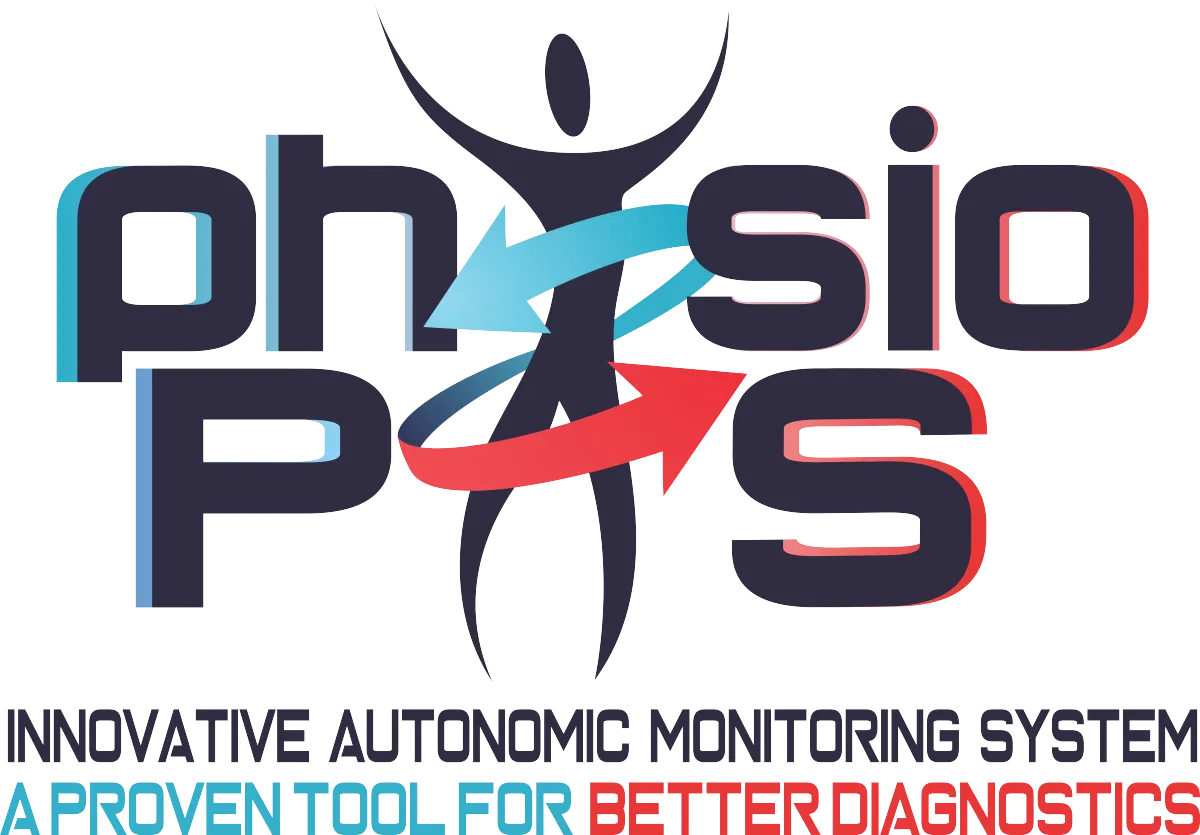INTRODUCING
The Best ANS Test
Help your patients heal smarter, faster, and more completely—with insights you can measure.
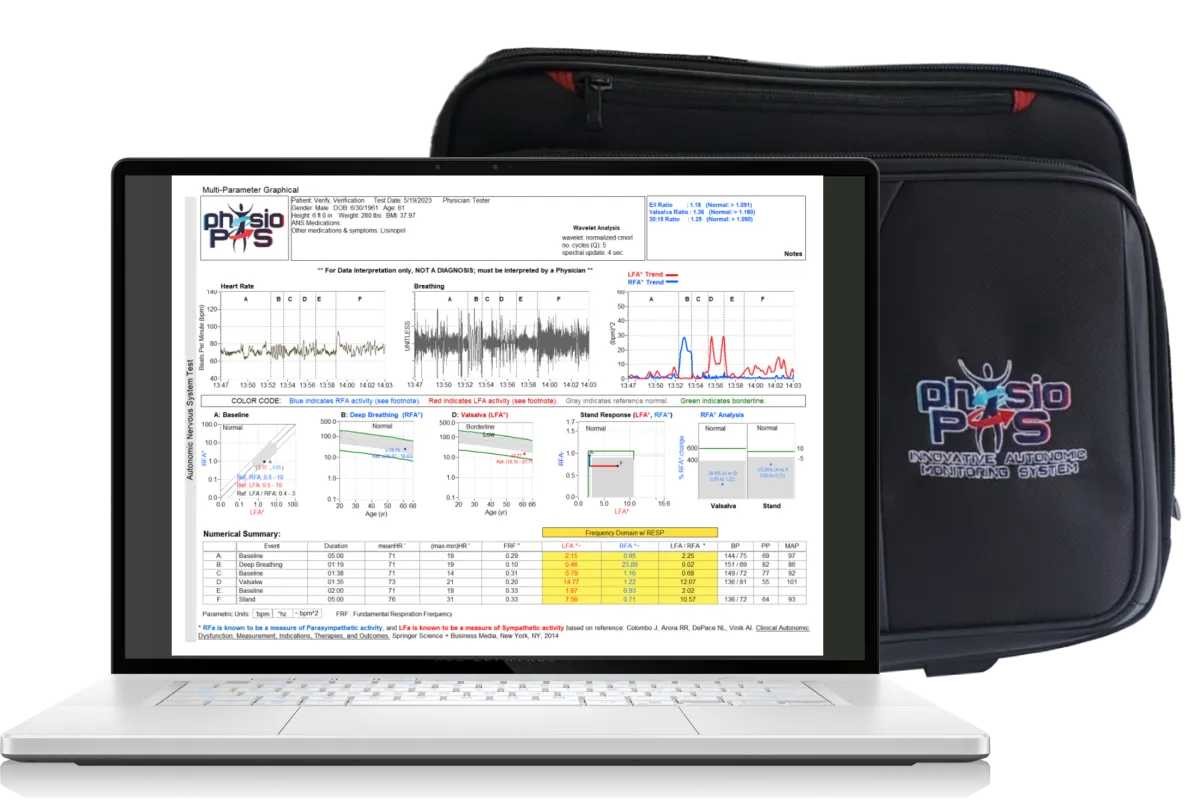
Drive More Revenue
Differentiate Your Practice
SaMD (Software as Medical Device)
Completely Non-Invasive
Portable
Provide More Precise, Data-Driven Care
Separate Structural VS. Neurological Causes
Pinpoint Why Pain or Fatigue Isn’t Resolving
Quantify Treatment Progress
Provide Clinical Clarity to Symptoms
Increase Revenue
Gain Reviews
Grow Referrals
Reveal the Missing Link in Chronic Pain, Fatigue & Recovery Issues
Many patients with persistent symptoms, chronic pain, fatigue, brain fog, and poor sleep have underlying Autonomic Nervous System (ANS) dysfunction that traditional orthopedic and neurological exams often miss. Physio PS helps you uncover and treat the true root cause, not just manage symptoms.
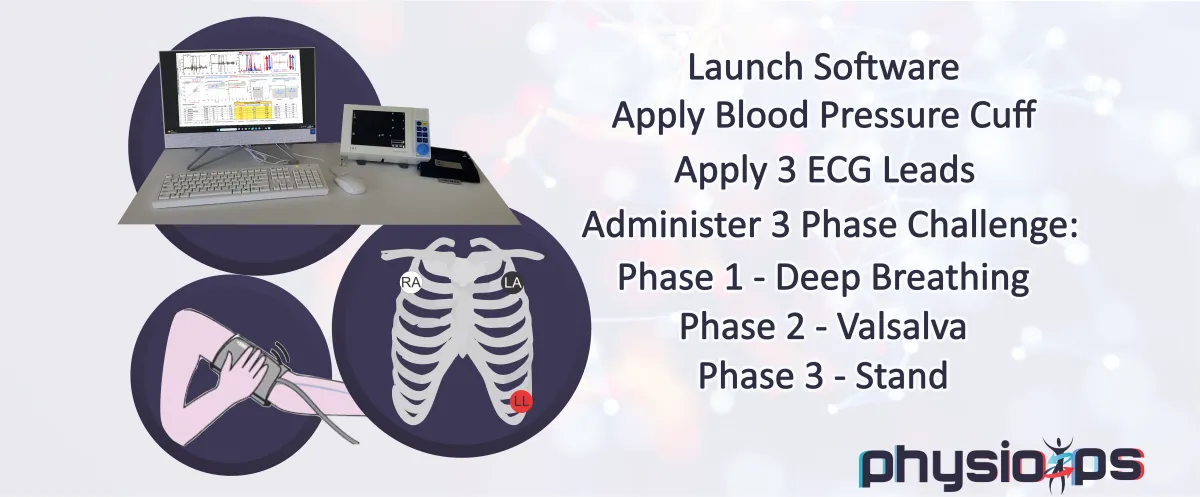
Why Physio PS
Brings Objectivity to Complex Cases
Chronic conditions like long-COVID, chronic fatigue, insomnia, and autonomic-driven pain often go undiagnosed or mismanaged because standard physical therapy and chiropractic assessments lack physiological insights.
Physio PS bridges this gap, providing real-time data on nervous system function to tailor more effective interventions.
Targets Underlying Issues in Cerebral Perfusion
Patients with parasympathetic excess (PE) and sympathetic withdrawal (SW) experience poor cerebral blood flow, leading to symptoms like brain fog, dizziness, and autonomic instability.
Physio PS helps physical therapists and chiropractors identify perfusion deficits and implement neurovascular strategies to restore proper function.
Optimizes Exercise Prescriptions Based on ANS Condition
Many patients overtrain or undertrain because their nervous system state isn’t accounted for in rehab programming.
Physio PS helps determine if a patient is ready for load progression or needs autonomic recovery strategies first.
Transforms Patient Education & Compliance
Instead of subjective descriptions, physical therapists and chiropractors can now show patients real-time graphs of their nervous system function, leading to stronger engagement, trust, and adherence.
Expands Physical Therapists & Chiropractors Role Beyond Traditional Care
With Physio PS testing, physical therapists and chiropractors can move beyond musculoskeletal care and into autonomic dysfunction management, a rapidly growing field with high demand.
Integrates Seamlessly into Current Physical Therapy & Chiropractic Workflows
Physio PS requires no invasive procedures and integrates into standard physical therapy and chiropractic evaluations, enhancing, rather than replacing, current assessment protocols.
Get real-time data.
Personalize care.
Convert tough cases.
Grow referrals.
Gain new revenue programs.
Provide More precise, Data-Driven Care
Accelerate Patient Recovery
Improve Professional Credibility
Expand Market Reach
Reasons To Integrate Physio PS Autonomic Nervous System Testing
Identifies Hidden Dysfunctions in Chronic Pain & Fatigue Patients
Many patients with chronic pain, persistent fatigue, and insomnia have underlying autonomic nervous system (ANS) dysfunction, which standard musculoskeletal assessments miss.
Physio PS testing pinpoints ANS imbalances, allowing physical therapists and chiropractors to address root causes rather than just symptoms.
Reveals the Role of Cerebral Perfusion in Chronic Conditions
Patients with parasympathetic excess (PE) or sympathetic withdrawal (SW) often have impaired cerebral perfusion, leading to brain fog, fatigue, poor recovery, and autonomic-driven pain.
Physio PS objectively measures these states, helping physical therapists and chiropractors customize interventions that restore optimal blood flow, oxygen delivery, and nervous system regulation.
Distinguishes Autonomic vs. Musculoskeletal Causes of Symptoms
Many non-resolving pain cases (e.g., fibromyalgia, CRPS, and post-concussion syndrome) have an autonomic component rather than a purely orthopedic one.
Physio PS allows physical therapists and chiropractors to differentiate between musculoskeletal vs. autonomic origins, ensuring appropriate treatment selection.
Enhances Treatment Precision & Progress Tracking
Traditionally, physical therapists and chiropractors rely on pain scales and functional assessments, which can be subjective and unreliable.
Physio PS provides quantifiable data on autonomic function, guiding treatment adjustments based on real-time nervous system feedback.
Improves Patient Outcomes & Compliance
Patients struggling with chronic pain, POTS, or dysautonomia often feel unheard due to the lack of objective findings.
Physio PS gives tangible proof of dysfunction, increasing patient buy-in and adherence to prescribed treatments.
Supports Faster Recovery & Reduces Therapy Plateaus
Patients with ANS dysfunction often stall in recovery because their body remains in a stress-dominant state.
Physio PS helps physical therapists and chiropractors detect these roadblocks early, allowing for strategic nervous system resets that accelerate healing and optimize rehabilitation outcomes.
Strengthens Referral Networks & Expands Physical Therapy & Chiropractic Scope
Physicians, cardiologists, and neurologists often struggle to objectively measure ANS function, making Physio PS a powerful tool for interdisciplinary collaboration.
Physical therapists and chiropractors can position themselves as leaders in nervous system rehabilitation, attracting more physician referrals and expanding treatment beyond standard orthopedic care.
Creates a Competitive Edge & New Revenue Streams
Physio PS testing sets physical therapists and chiropractors apart from competitors by offering cutting-edge autonomic diagnostics that few clinics provide.
It also opens doors for cash-based services related to nervous system recovery, stress management, and performance optimization.
Provider Focus
Our technology is able to provide chiropractors and physical therapists more information to improve their assessment and prioritize therapy planning for a broad spectrum of symptom relief.
Autonomic Nervous System Dysfunction
The Missing Link in Managing Hypermobility & EDS
As a chiropractor or physical therapist, you’ve likely encountered patients with joint hypermobility or Ehlers-Danlos Syndrome (EDS) who just don’t respond to care as expected.
Despite thorough assessments, proper stabilization programs, and evidence-based manual therapy, their symptoms persist. Why? One often-overlooked factor could be the autonomic nervous system (ANS) — a critical regulator of homeostasis, recovery, and pain perception.
Why the ANS Matters in Hypermobility and EDS
The ANS controls automatic bodily functions like heart rate, blood pressure, digestion, and temperature regulation. In patients with hypermobility or EDS, autonomic dysfunction is not only common — it’s often debilitating.
Research and clinical observation show a high prevalence of dysautonomia in these populations, including:
Postural Orthostatic Tachycardia Syndrome (POTS)
Orthostatic Intolerance
Neurocardiogenic Syncope
Gastrointestinal Dysmotility
Chronic fatigue and temperature dysregulation
These symptoms can mimic or exacerbate musculoskeletal complaints, confusing clinical outcomes and delaying progress.
What it means to your patients
Understanding autonomic function transforms your ability to treat hypermobility and EDS. Instead of chasing symptoms or misattributing flare-ups, you're now working with a complete picture of the patient's physiology.
Patients feel seen, providers gain clarity, and care becomes more precise, efficient, and rewarding.
Recognizing ANS Dysfunction in Your Patients
Many non-resolving pain cases (e.g., fibromyalgia, CRPS, and post-concussion syndrome) have an autonomic component rather than a purely orthopedic one.
Physio PS allows physical therapists and chiropractors to differentiate between musculoskeletal vs. autonomic origins, ensuring appropriate treatment selection.
Objective Assessment: Integrating ANS Testing into Practice
Advancements in technology now allow for non-invasive autonomic testing in clinical settings.
Physio PS enables practitioners to:
Identify sympathetic vs. parasympathetic imbalances.
Validate patients' symptoms with data.
Customize care to improve outcomes.
Establish objective baselines and track progress.
Open new channels for physician referrals and revenue.
For many providers, adding ANS testing has been a clinical game-changer — especially in managing complex cases like EDS.
Elevate Your Practice
Learn how identifying autonomic dysfunction can improve the lives of your patients.
Download Dr. Colombo's Free eBook!
Multi-Parameter Graph Report
Using patented, advanced autonomic monitoring technology, Physio PS offers precise, real-time insights into autonomic nervous system performance—empowering more accurate assessments and targeted interventions.
Easy to understand diagnostic data provides unprecedented insight into the health of the autonomic nervous system.
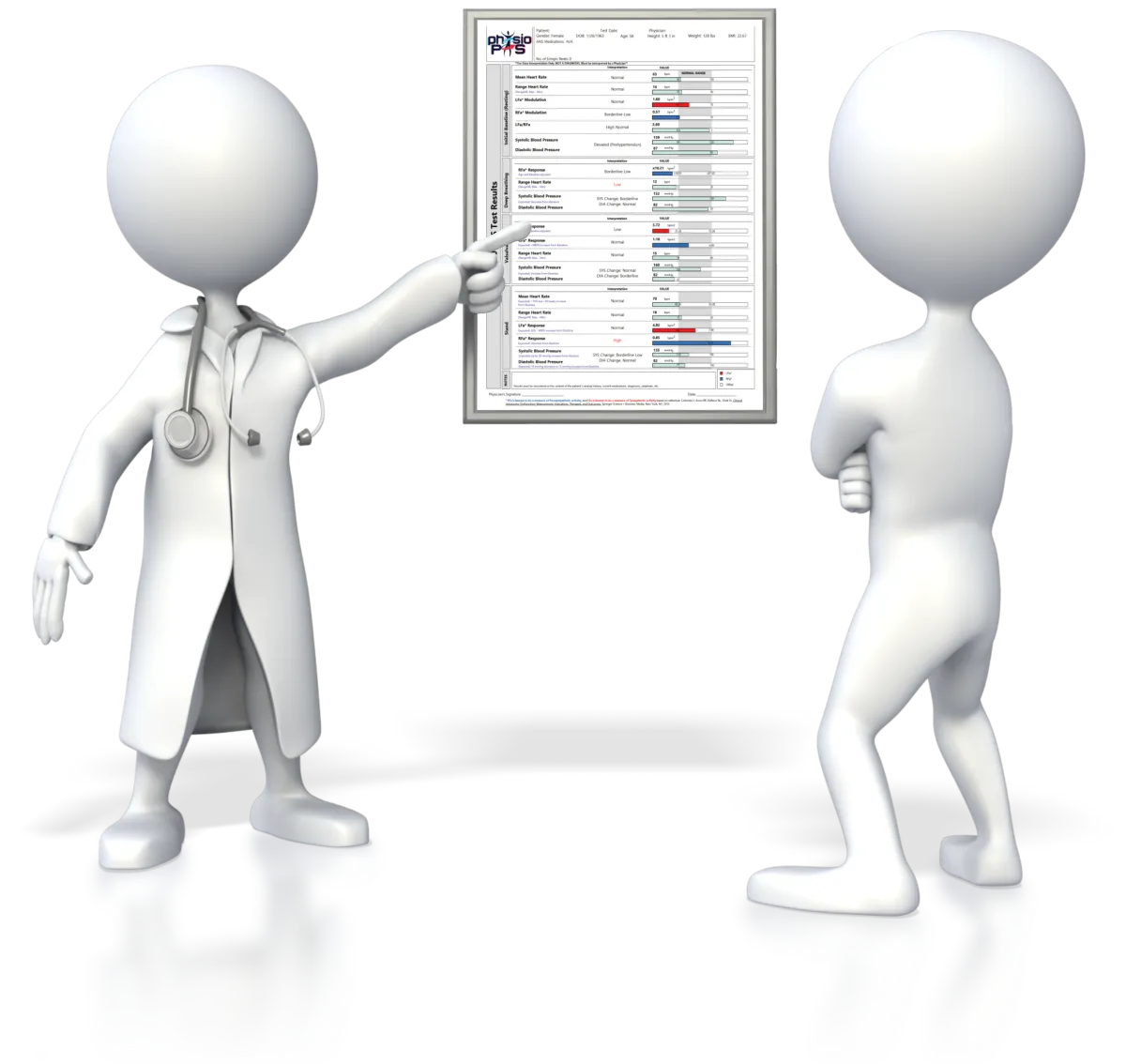
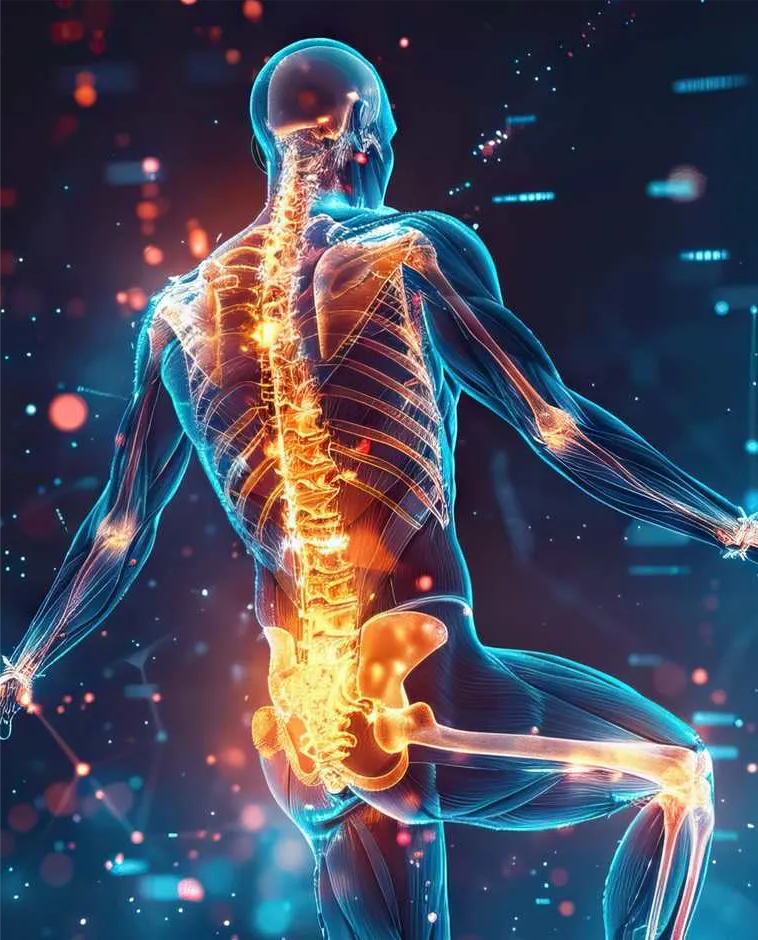
Bridge the Gap Between Structure and Function
Whether you're correcting alignment or improving movement patterns, autonomic imbalance can stall recovery. Physio PS allows you to evaluate cerebral perfusion, vagal tone, and parasympathetic-sympathetic balance, ensuring your treatments are supported by the nervous system, not blocked by it.

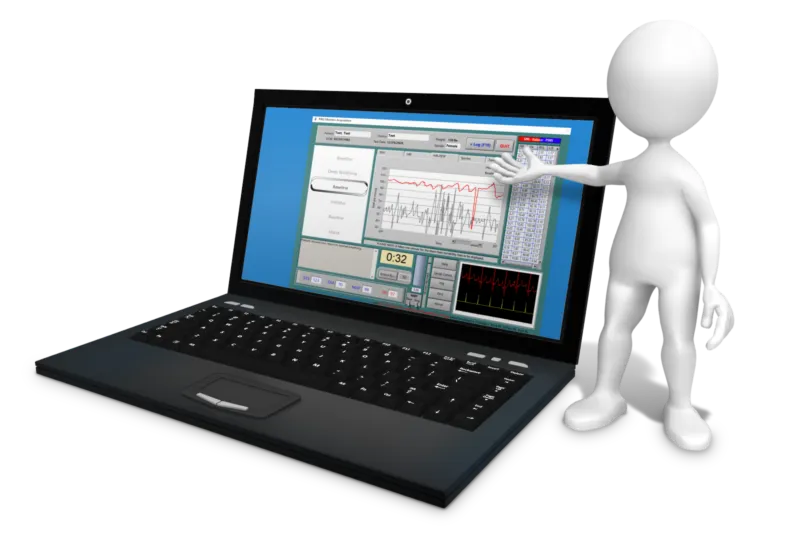
Quantify What You Can’t See: Real-Time Nervous System Metrics
Go beyond subjective pain scales and functional tests. Physio PS provides objective data on stress load, cardiovascular balance, and autonomic function—offering clear guidance for treatment strategies and easy-to-track patient progress.

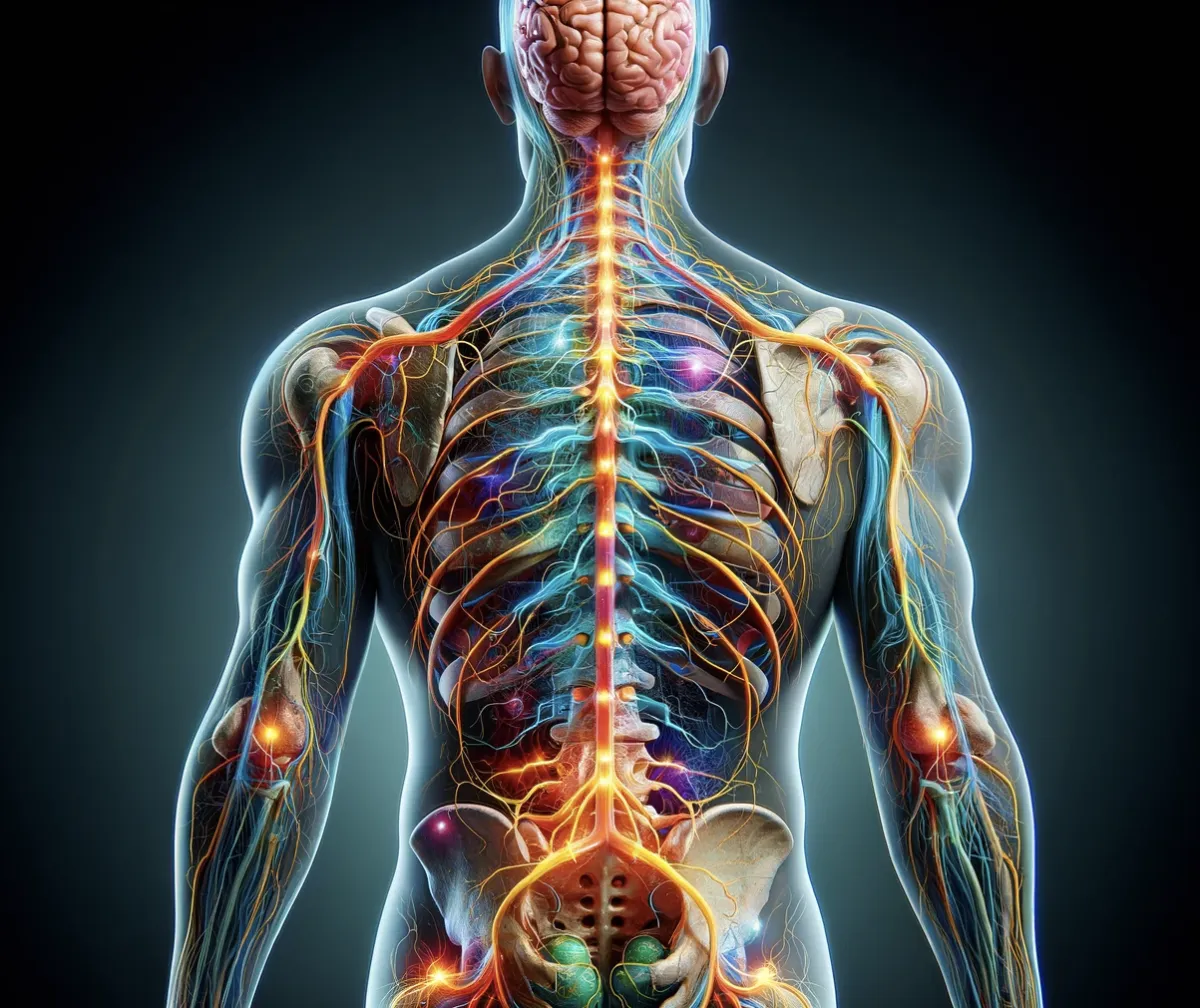
Elevate Your Role as a Nervous System Specialist
Chiropractors and physical therapists trained in the neuromusculoskeletal system are uniquely positioned to interpret and act on autonomic data. Physio PS helps you stand out as a leader in nervous system-based care, attracting referrals from MDs, neurologists, and cardiologists.

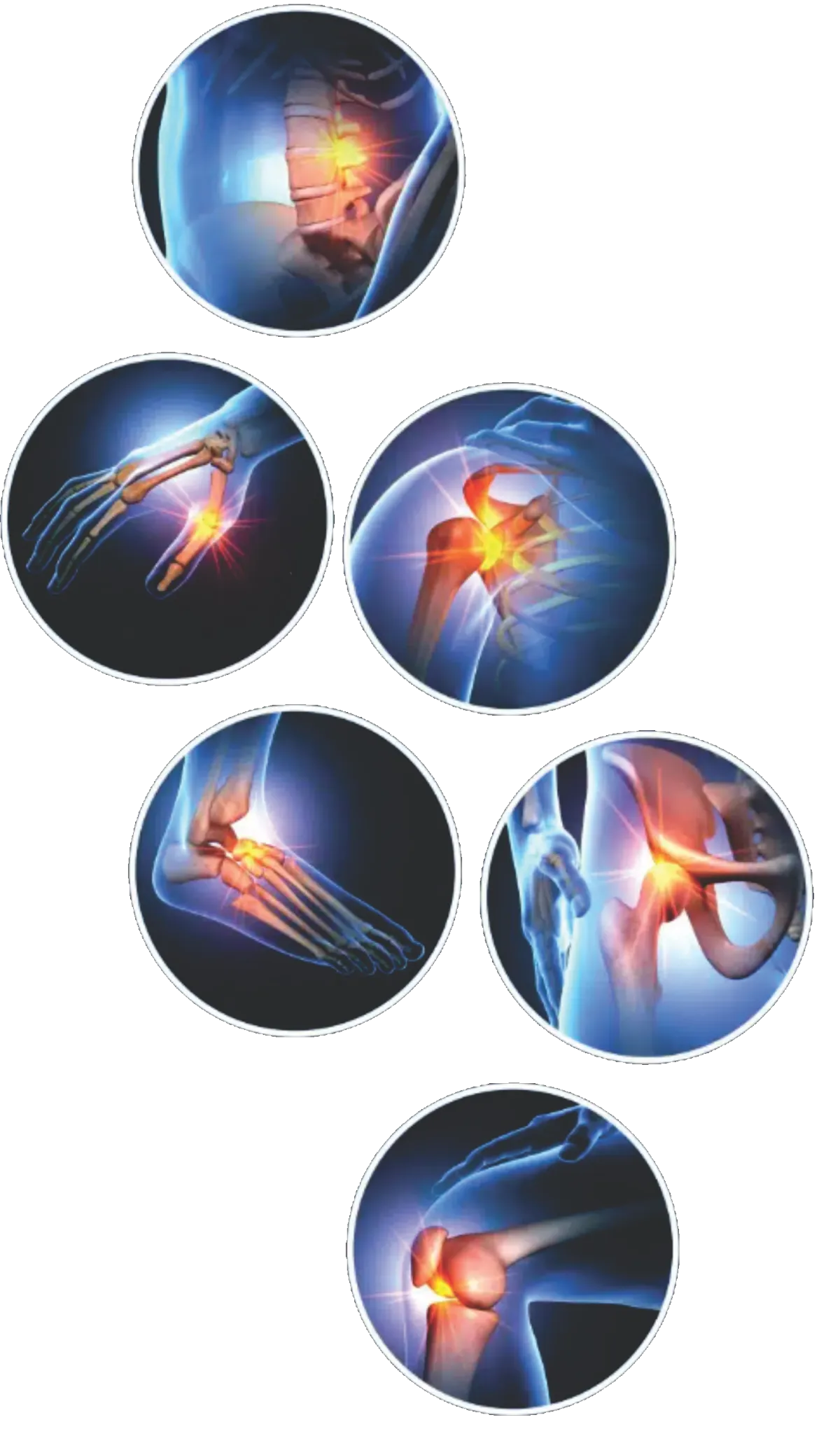
Differentiate Between Structural vs. Neurological Causes
In tough cases like fibromyalgia, post-concussion syndrome, CRPS, or POTS, symptoms may stem from ANS dysfunction—not purely musculoskeletal or spinal. Physio PS testing empowers you to pinpoint the origin and tailor care with greater accuracy.

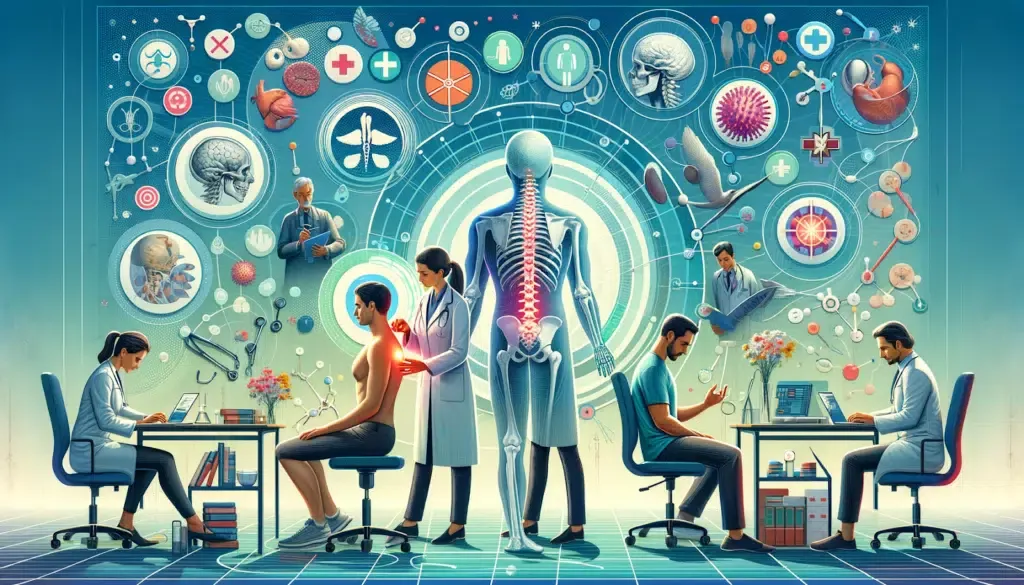
Improve Patient Buy-In & Long-Term Outcomes
Patients struggling with “invisible illnesses” often feel dismissed. With Physio PS, you can show them concrete evidence of dysfunction, increasing trust, compliance, and enthusiasm for your care plan.

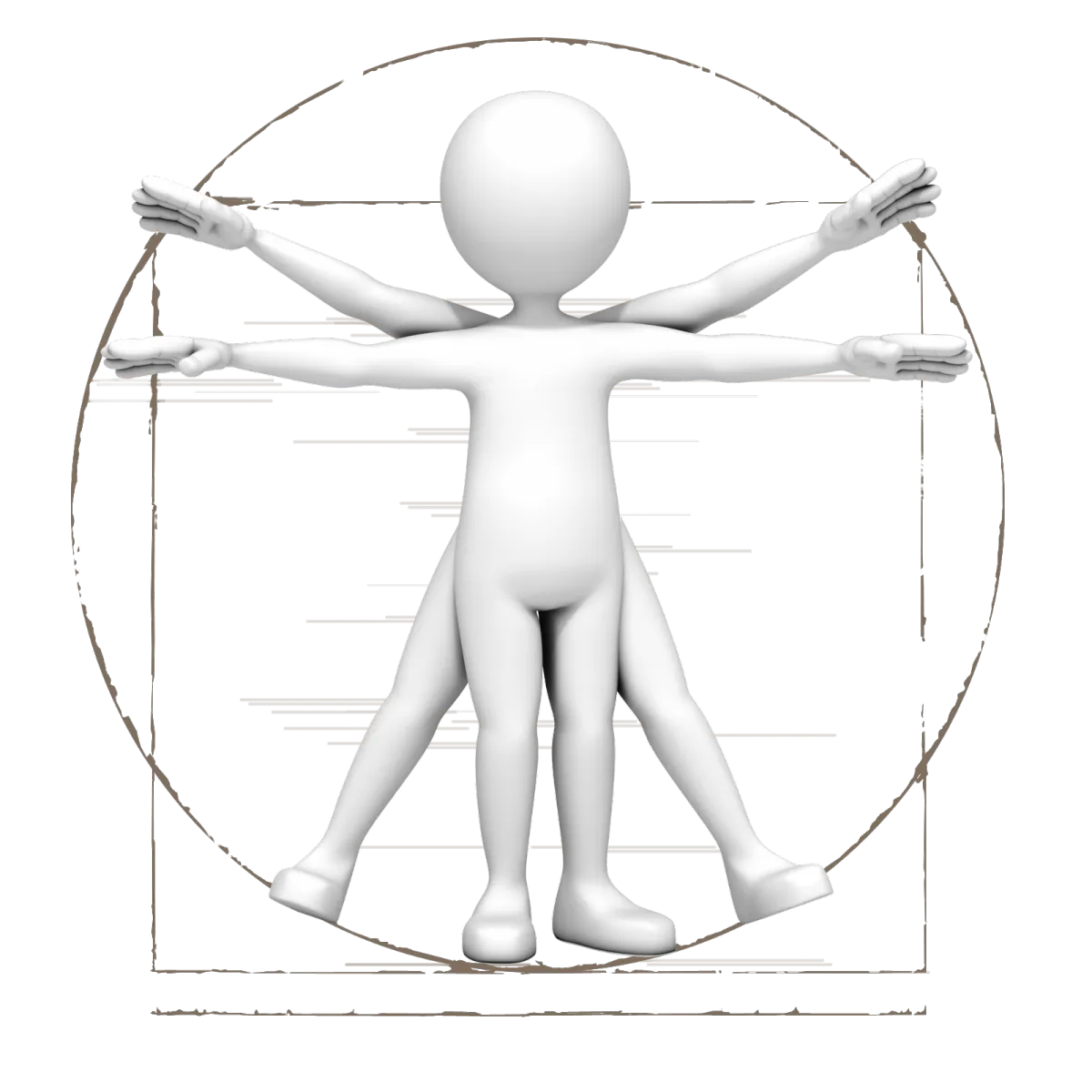
Eliminate Recovery Plateaus
ANS dysfunction is a hidden reason why some patients don't respond to care. Use Physio PS to identify sympathetic overdrive, parasympathetic fatigue, or vagal dysregulation; then apply targeted resets to restart healing and progress.


Gain a Competitive Edge with Cash-Based Services
From stress recovery to chronic pain management to performance enhancement, Physio PS testing enables premium services your competitors aren’t offering. Add value, improve outcomes, and grow your revenue.

About Us
Thank you for taking the time to learn more about our team at Physio PS.
Our mission at Physio PS is to improve the way people understand and respond to imbalances in the Autonomic Nervous System and how it relates to their overall health and well-being.
With many years of research and development of this incredibly unique means of monitoring the ANS, doctors throughout the world use our technology to improve the lives of their patients and better the outcome of treatment.

Proudly Utilized In Research Projects At The Accredited

Testimonials
Sean O. Flannagan
PT, DPT, Cert. SMT, Cert. DN, MAACP

Physio PS has been a gamechanger in uncovering the hidden autonomic dysfunctions that often underlie chronic fatigue, persistent pain, anxiety symptoms, and delayed recovery after whiplash and concussion. It’s given us answers when nothing else could — and a clear path to true healing.
Heather Bloom
MD, FACC, Director of Cardiac Electrophysiology, Atlanta VAMC Associate Professor, Emory University School of Medicine

As a VA Electrophysiologist, I’ve used the Physio PS technology for Parasympathetic and Sympathetic Monitoring for years with outstanding results. It delivers diagnostic insights no other tool can provide. One case—a Navy SEAL suffering from severe dizziness and disability—was accurately diagnosed and effectively treated using this technology, after traditional tests failed. The patient regained his health, quality of life, and independence. This tool is a game-changer for patient care and healthcare efficiency.
Michael Stopyra

I cannot say enough good things about Physio PS! This technology has done so much for me. I used to have terrible anxiety storms that would cause me to have high fevers. With this simple test, my doctor was able to find the root cause of my symptoms and prescribe a very low-dose medicine for about nine months to correct the primary problem. I have not had a high fever in four years!

